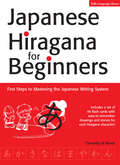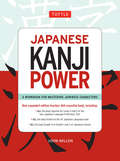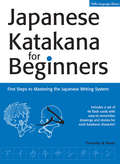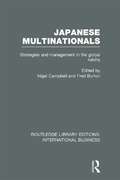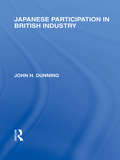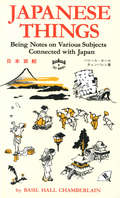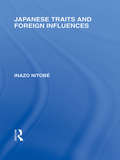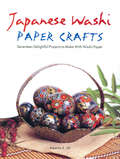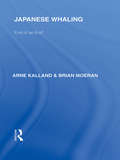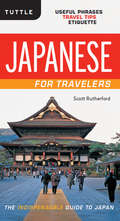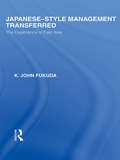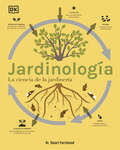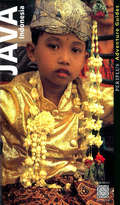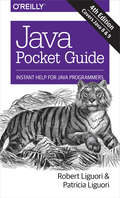- Table View
- List View
Japanese Hiragana & Katakana for Beginners
by Timothy G. StoutThe method that's helped thousands in the U.S. and Japan learn Japanese successfully.Japanese has two basic writing systems, hiragana and katakana, in addition to the one that uses Chinese characters or Kanji. <P><P> This handy book teaches you a new mnemonics-based method to read and write the basic 92 hiragana and katakana characters.Memorable picture mnemonics help you to learn the characters by associating their shapes and sounds with combinations of images and English words already familiar to you.Clear examples and entertaining exercises offer opportunities to read, write, use and practice all 46 basic hiragana and 46 basic katakana characters, plus the remaining kana that stand for more complex sounds.Polish your knowledge with word searches, crossword puzzles, fill-in-the-blanks, timed recognition quizzes, and other interesting activities.The Downloadable Content allows you to print out your own flash cards (featuring the same mnemonic images taught in the book) to help you review and practice, even while you're on the go.
Japanese Hiragana for Beginners: First Steps to Mastering the Japanese Writing System
by Timothy G. StoutLearn how to write all the basic Japanese hiragana with this user-friendly workbook.<P><P>Japanese Hiragana for Beginners makes learning hiragana fast and effective by using memorable picture mnemonics, along with clear explanations, examples and lots of fun exercises-a method that has helped thousands of students learn hiragana successfully in the United States and Japan. Picture mnemonics enhance memory by associating the shape and sound of each hiragana character with combinations of images and English words already familiar to students.This Japanese language learning book is divided into three main sections: Section 1 introduces the basic 46 hiragana characters along with writing tips and practice exercises. Section 2 teaches the usage rules that allow students to write Japanese sounds. Section 3 strengthens students' skills through a wide range of exercises (word searches, crossword puzzles, fill in the blanks, visual discrimination, timed quizzes, etc).A set of flash cards printed on perforated cardstock and a list of suggested flash card activities, are also provided at the end of the book. Each of these cards introduces a hiragana character along with picture mnemonic that helps to recognize and remember it.
Japanese Kanji Power
by John MillenJapanese Kanji Power is a workbook for mastering Japanese characters (Kanji) with the added power of a dictionary.This resource is essential for the serious student looking to get an A in Kanji class or the language enthusiast ready to take written Japanese to the next level. This new expanded edition teaches all 464 essential Kanji required for Levels 4 and 5 of the new Japanese Language Proficiency Test and the AP Japanese Language exam. Each Kanji is presented with the information needed to learn and remember the character and its many variations and uses. Cumulative exercises allow students to practice the Kanji and strengthen existing knowledge. An indexing feature allows Japanese Kanji Power to function as a Kanji dictionary.The presentation of each Kanji incorporates a number of key features, including:Several example sentences that introduce each kanji reading in contextA list of frequently-used compounds and phrases that allows you to increase your practical vocabularyBackground information, such as the original of the character of a mnemonic to aid in memorizationStroke count and a stroke-order diagramWriting hints and a writing practice gridNumerous exercises and frequent reviews for reinforcement
Japanese Kanji and Kana
by Mark Spahn Wolfgang HadamitzkyThis is a self-study book for leaning Japanese Kanji and KanaLong the leading book for learning Japanese Characters, Japanese Kanji and Kana is the resource you need to master the basic Japanese characters (kanji) and the hiragana and katakana syllabaries (known collectively as kana).Complete, compact and essential, this is the resource you need in order to use and master kanji. This new edition reflects the recent update by the Japanese government of the official Joyo kanji list. Joyo means "daily use," and these 2,136 kanji are the ones that every Japanese person learns in public education. The kana and kanji are presented in an easy to understand format. A concise indexing section also allows the book to function as a Japanese dictionary and plenty of extra space is allowed for writing Kanji and writing Kana. All the characters are written clearly making reading kanji and reading kana effortless.This book features:All 2,136 official Joyo kanji with readings and meaningsUp to 5 useful compounds for each kanjiBrush & pen forms, too-not only printed form19 convenient tables summarizing key info about the languageEasy access to all kanji via 3 indexes: by radical, stroke count, and readings
Japanese Kanji and Kana
by Mark Spahn Wolfgang HadamitzkyThis comprehensive book helps you learn the 92 basic Kana characters and 2,136 standard Kanji characters.Complete, compact and authoritative--this book provides all the information needed to learn the Japanese writing system, including the 92 basic hiragana and katakana phonetic symbols (known collectively as Kana) and the 2,136 standard Joyo Kanji characters that every Japanese person learns in school.The kana and kanji are presented in an easy and systematic way that helps you learn them quickly and retain what you have learned and improve your mastery of the Japanese language--the ability to read Japanese and write Japanese is an essential skill for any student. A concise index allows you to look up the Kanji in three different ways (so the book also serves as a Japanese Kanji dictionary) and extra spaces are provided to allow you to practice writing Japanese. This book contains: All 2,136 official Joyo kanji with readings and definitions. Characters are graded by their JLPT examination levels. Up to 5 useful vocabulary compounds for each kanji. Brush and pen cursive forms as well as printed forms. 19 tables summarizing key information about the characters. Kanji look-up indexes by radicals, stroke counts and readings.
Japanese Kanji and Kana
by Mark Spahn Wolfgang HadamitzkyThis comprehensive book helps you learn the 92 basic Kana characters and 2,136 standard Kanji characters.Complete, compact and authoritative-this book provides all the information needed to learn kanji and kana, including the 92 basic hiragana and katakana phonetic symbols (known collectively as Kana) and the 2,136 standard Joyo Kanji characters that every Japanese person learns in school.The kana and kanji are presented in an easy and systematic way that helps you learn them quickly and retain what you have learned and improve your mastery of the Japanese language-the ability to read Japanese and write Japanese is an essential skill for any student. A concise index allows you to look up the Kanji in three different ways (so the book also serves as a Japanese Kanji dictionary) and extra spaces are provided to allow you to practice writing Japanese. This book contains: All 2,136 official Joyo kanji with readings and definitions. Characters are graded by their JLPT examination levels. Up to 5 useful vocabulary compounds for each kanji. Brush and pen cursive forms as well as printed forms. 19 tables summarizing key information about the characters. Kanji look-up indexes by radicals, stroke counts and readings.
Japanese Katakana for Beginners First Steps to Mastering the Japanese Writing System (Tuttle Language Library)
by Timothy G. StoutThis is a user-friendly guide to learning Japanese Katakana and includes a set of 46 flash cardsJapanese Katakana for Beginners makes learning of katakana fast and effective by using memorable picture mnemonics, along with clear explanations, examples and lots of fun exercises, a method that has helped thousands of students lean katakana successfully in the United States and Japan. <P><P>Picture mnemonics enhance memory by associating the shape and sound f each katakana character with combinations of images and English words already familiar to students. This book is organized into three main sections:The first introduces the basic 46 katakana characters along with writing tips and opportunities to practice writing them.The secondteachers the usage rules that allow students to write all Japanese sounds, providing more opportunities for practice.The third strengthens students' skills through a wide range of exercises (word searches, crossword puzzles, fill in the blanks, visual discrimination, timed recognition quizzes, etc) designed to both increase the knowledge of the Japanese language and reinforce newly acquired writing skillsA set of flash cards printed on perforated cardstock and a list of suggested flash card activities, are also provided at the end of the book. Each of these cards introduces a katakana character along with the picture mnemonic that helps to recognize and remember it.
Japanese Multinationals: Strategies and Management in the Global Kaisha (Routledge Library Editions: International Business)
by Fred Burton Nigel CampbellInternational in perspective, this volume provides insights into the important problem of how to transfer Japanese practice to Western countries. It also examines key aspects of Japanese multinationals and discusses how they are developing their global strategies and how they are managing their local workforces. Topics covered include relations with suppliers, governments and competitors, leadership patterns and business philosophy. The impact of Japanese multinationals on the local economies of host countries is a particular focus. The dynamics of strategic alliances, technology transfers and research and development centres are also discussed.
Japanese Participation in British Industry (Routledge Library Editions: Japan)
by John DunningJapanese participation in British industry has increased greatly in recent years. While the new investment is welcomed for the jobs it helps create and the injection of new technology and managerial techniques, many people are fearful lest this increased participation should lead to loss of control of British industry by British nationals and adversely affect British competitors and their struggle for global markets. These concerns are made worse by lack of knowledge about just how extensive Japanese managerial participation in British industry is and about how Japanese practices differ. This book, based on extensive original research, answers these and related questions. It is the first detailed study of the extent of Japanese participation in British industry, and of its economic impact in a number of key areas.
Japanese Secrets to Beautiful Skin & Weight Control
by Lucille Craft Grace MaedaThis book is written just for you. It is based on the simple and natural principle that diet and bathing are the most important factors in creatinghealthy, beautiful skin and a general feeling of well-being. And once your skin glows and you feel full of energy and enthusiasm, you are well on the way to realizing your complete beauty potential. How would you rate your physical condition and appearance? Are you satisfied with the way you are, or would you say there is room for improvement? Do you feel frustrated because it is difficult to find the time-much less the e n e r g y - t o give attention to health and beauty maintenance? In today's fast-paced world, time for personal care and relaxation is often forgotten, yet the price of neglect is too high to pay. Your eating habits, beauty routines, and techniques for managing stress allneed to be as simple, streamlined, and effective as possible. To meet this need, the Maeda Program combines the best of Western medical knowledge with tried-and-true Japanese methods to create an easy-to-follow routine ideal for today's busy woman.
Japanese Slang
by Peter ConstantineReveals, in vivid detail, the richness of Japanese slang in all its amusing, bizarre and shocking forms.
Japanese Things
by Basil Hall ChamberlainArmchair travelers beware!Japanese Things will lure you out of your cozy, comfy home and chair to an unusual country with bewitching manners and customs-and once you have succumbed to its spell you will never be the same. Here in one neat package you will meet the flavor, charm, and piquancy of old Japan-a revised reprint of one of the indispensable books on Japan, by the late Prof. Basil Hall Chamberlain,eminent British scholar who in the latter part of the 19th century "taught Japanese and Japan to the Japanese." Many books in one, this monumental compilation contains such diversified subjects as Art and Abacus; Botany and Buddhism; Charms and Cherry Blossoms; Daimyos and Divination; Fairy Tales and Flowers; Gardens and Government; History and Hara-kiri; Law and Language; Marriage and Music; Poetry and Pottery; Shinto and Singing Girls (Geisha); Tea and Theater, and Writing and Wood Engraving. In this long-awaited reprint, in which the title has been changed from Things Japanese, the reader will encounter exquisite objects of daily Japanese life, the gardens and cultures of the fields, the harmony and balance in the fundamentals of day-by-day existence.
Japanese Things
by Basil Hall ChamberlainArmchair travelers beware!Japanese Things will lure you out of your cozy, comfy home and chair to an unusual country with bewitching manners and customs-and once you have succumbed to its spell you will never be the same. Here in one neat package you will meet the flavor, charm, and piquancy of old Japan-a revised reprint of one of the indispensable books on Japan, by the late Prof. Basil Hall Chamberlain,eminent British scholar who in the latter part of the 19th century "taught Japanese and Japan to the Japanese." Many books in one, this monumental compilation contains such diversified subjects as Art and Abacus; Botany and Buddhism; Charms and Cherry Blossoms; Daimyos and Divination; Fairy Tales and Flowers; Gardens and Government; History and Hara-kiri; Law and Language; Marriage and Music; Poetry and Pottery; Shinto and Singing Girls (Geisha); Tea and Theater, and Writing and Wood Engraving. In this long-awaited reprint, in which the title has been changed from Things Japanese, the reader will encounter exquisite objects of daily Japanese life, the gardens and cultures of the fields, the harmony and balance in the fundamentals of day-by-day existence.
Japanese Things
by Basil Hall ChamberlainArmchair travelers beware!Japanese Things will lure you out of your cozy, comfy home and chair to an unusual country with bewitching manners and customs-and once you have succumbed to its spell you will never be the same. Here in one neat package you will meet the flavor, charm, and piquancy of old Japan-a revised reprint of one of the indispensable books on Japan, by the late Prof. Basil Hall Chamberlain,eminent British scholar who in the latter part of the 19th century "taught Japanese and Japan to the Japanese." Many books in one, this monumental compilation contains such diversified subjects as Art and Abacus; Botany and Buddhism; Charms and Cherry Blossoms; Daimyos and Divination; Fairy Tales and Flowers; Gardens and Government; History and Hara-kiri; Law and Language; Marriage and Music; Poetry and Pottery; Shinto and Singing Girls (Geisha); Tea and Theater, and Writing and Wood Engraving. In this long-awaited reprint, in which the title has been changed from Things Japanese, the reader will encounter exquisite objects of daily Japanese life, the gardens and cultures of the fields, the harmony and balance in the fundamentals of day-by-day existence.
Japanese Traits and Foreign Influences (Routledge Library Editions: Japan)
by Inazo NitobeThis volume collects together essays and lectures given by the author from 1922-1927 to a variety of international audiences. Together they illuminate essential aspects of the Japanese mentality and way of life, particularly in social, religious and linguistic aspects.
Japanese Village Ils 56: A Japanese Village (International Library of Sociology #No. 14)
by John F. Embree"First Published in 1998, Routledge is an imprint of Taylor & Francis, an informa company."
Japanese Washi Paper Crafts
by Robertta A. UhlIn Japan, paper and paper crafts are held in popular esteem. The originators of origami, the art of paper-folding, and kirigami, the art of paper-cutting, the Japanese also make their own paper, called washi. A colorful printed paper, washi is used to decorate everything from boxes to dolls. Noted for its strength, durability and flexibility, washi paper is available in a rich array of colors, textures, weights and patterns.Japanese Washi Paper Crafts is a selection of seventeen designs for decorating commonly available objects, such as milk cartons, boxes and eggs, which can be used in home decor, as gifts, or for special occasions. Every project is shown with clear, step-by-step diagrams. Color photographs show completed projects, as well as imaginative ways for displaying the finished crafts.
Japanese Whaling?: End of an Era (Routledge Library Editions: Japan)
by Brian Moeran Arne KallandThis book gives a social anthropological account of whaling culture in Japan. When originally published this was the first comprehensive account in English of the history of Japanese whaling, showing how it has given rise to a particular culture. The volume discusses what happens when that culture is threatened. At the same time as explaining the work organization of those involved in whaling, the role of whaling companies in local and national economies, and the role of the whale in the establishment and maintenance of local community identity (ritual, food, gift-giving), the authors address the wider political and so-called "environmental" issues surrounding whaling in general, and Japanese whaling in particular.
Japanese for Travelers: Useful Phrases Travel Tips Etiquette (Japanese Phrasebook)
by Scott RutherfordThis ebook is a combination Japanese phrase book, Japanese travel guide and Japanese etiquette guide. <P><P>Packed with expressions and information for everyday occasions (looking for a place to stay, eating at a restaurant, making a telephone call), as well as less common ones (what to do if you become ill or something is lost or stolen), Japanese for Travelers allows you to break out of the role of passive spectator during your time in Japan and allow you to speak Japanese with locals. Helpful illustrations demystify Japan's sometimes intimidating rail system and provide handy information of ferry travel as well. The text offers travel tips ranging from where to go for a cheap, comfortable night's sleep (you'd be surprised) to whom not to stand behind when in line at customs.A breed apart from run-of-the mill Japanese phrasebooks, Japanese for Travelers is a tool for the traveler who is out not only to survive, but succeed, while staying in Japan. Sections include:Basic CommunicationMoneyMailGetting aroundEating and restaurantsLodgingLeisureDealing with problems such as illness
Japanese-Style Management Transferred: The Experience of East Asia (Routledge Library Editions: Japan)
by K J FukudaJapan’s rapid rise to economic super-power status has led to a worldwide interest in and attempts to emulate Japanese management practices. This book, based on extensive original research, considers both the opportunities and problems of the transfer of Japanese management practices to other areas in East Asia. It remains one of the few books of its kind, as other books on Japanese management have concentrated on its transferability to the West. Because many Japanese subsidiaries have been established longer in East Asia than elsewhere and the local work forces have become accustomed to Japanese management practices when transferred elsewhere have become apparent in a way they have not where Japanese management practices are much newer.
Japonés (Idiomas para viajar #Volumen)
by El País-AguilarIdiomas para viajar ofrece ahora unos contenidos mucho más amplios y completos. Cada guía recoge todo lo que se necesita para desenvolverse durante el viaje: una guía de pronunciación, un resumen gramatical y un manual básico del idioma como introducción a todos los bloques temáticos pensados para resolver situaciones según avanza el viaje (llegada, desplazamientos, alojamiento, restaurantes, ocio, compras, salud, emergencias#). Un código de colores distingue los diferentes bloques temáticos para facilitar la consulta. Todos los capítulos tienen, además de introducciones prácticas del país, un vocabulario imprescindible y expresiones habituales, con sus correspondientes transcripciones. La guía concluye con un nuevo diccionario bilingüe, que contiene todas las palabras de uso habitual en la comunicación diaria.
Jardinología (The Science of Gardening): La ciencia de la jardinería
by Dr. Stuart FarrimondUn libro de jardinería diferente que explica la ciencia detrás de la jardinería de forma visual y clara.¿El mundo de la botánica y la jardinería te parecen un misterio? Las guías de jardinería al uso tienden a dar gran cantidad de instrucciones y consejos, pero rara vez aportan explicaciones sobre el por qué. ¡No te preocupes! El Dr. Stuart Farromond arroja luz sobre todas esas preguntas que siempre te has hecho y te explica lo que sucede en tu jardín desde un enfoque científico.La guía botánica definitiva para entender los secretos de la horticultura y la floricultura como un profesional:Escrita con un lenguaje accesible y libre de tecnicismos en formato pregunta y respuesta. Con explicaciones claras, apoyadas por gráficos y esquemas para ilustrar los conceptos de forma visual.Estructurado en torno al ciclo de vida de un jardín, desde los primeros brotes hasta el momento de la poda.Explica los beneficios de la jardinería para la salud mental y el medio ambiente.Un práctico manual de jardinería con explicaciones y consejos avalados por la ciencia, que te ayudará a comprender mejor cómo se comportan las plantas, desmitificar creencias y descubrir las bases y avances de la horticultura moderna. ------------------------The only book to explain the science behind gardening practice in a simple and visually accessible way.The world of gardening can be a mystifying place, with so many instructions to follow and often little explanation as to why. Dr. Stuart Farromond casts his scientific eye over a typical year in the garden to answer all the horticultural questions you&’ve ever wanted the answer to. This great gardening book provides a shortcut to decades of gardening experience by explaining the science behind how a garden grows, featuring: An accessible guide structured around the life cycle of the garden, taking you from first shoots to pruning for renewal. An accessible Q &A format, with stats and infographics to bring the story to life, as well as long-held gardening myths are exploded by new science. Every way to greener fingers has an action point so that you can understand the science, apply your gardening practice, and enjoy a flourishing garden.From hands-on, practical advice, to an exploration of the mental health benefits of gardening, while also covering topics such as the positive impact gardening can have on the earth during a time of climate crisis in between, The Science of Gardening debunks myths and reveals the latest science only taught at horticultural college. As a passionate newcomer to gardening, daunted by the mountain of often conflicting advice in gardening manuals, Dr. Stu has set about testing the scientific basis of so much conventional wisdom and practice so you too can garden like a pro.
Java Adventure Guide
by Periplus EditorsThe ultimate adventure guideThis is the most comprehensive guide to Java ever produced. Hundreds of pages of travel tips and dozens of lively articles on history, nature, and the arts, take you right under the surface of Javanese life, with visits to lots of unique places.Under the volcanoJava's 121 active volcanoes rumble and roar above one of the world's most dramatic tropical landscapes. Whether you come here to trek the volcanoes or to visit the island's impressive ancient monuments, Java provides the adventure of a lifetime.The nitty gritty, from A to ZDetailed maps of all areas of interest are included along with personal recommendations from our expert authors on how to get around, where to stay and eat, and how to get the best value for your money.
Java Adventure Guide
by Periplus EditorsThis is the most comprehensive guide to Java ever produced. Hundreds of pages of travel tips and dozens of lively articles on history, nature and the arts, take you right under the surface of Javanese life, with visits to lots of unique places. Detailed maps of all areas of interest are included along with personal recommendations from our expert authors on how to get around, where to stay and eat, and how to get the best value for your money.
Java Pocket Guide: Instant Help for Java Programmers
by Patricia Liguori Robert LiguoriAny time you need quick answers for developing or debugging Java programs, this pocket guide is the ideal reference to standard features of the Java programming language and its platform. Youâ??ll find helpful programming examples, tables, figures, and lists fastâ??including Java 9 features such as modular source code and the new JShell interactive command-line REPL. Itâ??s a handy companion, whether youâ??re in the office, in the lab, or on the road.This book also provides material to help you prepare for the Oracle Certified Associate Java Programmer exam.Quickly find Java language details, such as naming conventions, types, statements and blocks, and object-oriented programmingGet details on the Java SE platform, including development basics, memory management, concurrency, and genericsUse new features in Java 9, including modular source code and JShellBrowse through information on basic input/output, NIO 2.0, the Java collections framework, and the Java Scripting APIGet supplemental references to fluent APIs, third-party tools, and basics of the Unified Modeling Language (UML)

